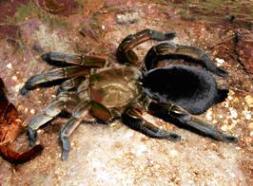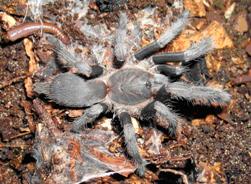Australian tarantulas (family Theraphosidae)


A land of spiders
Australia is a land of spiders. Wherever there is a secluded corner in any room in a house there will likely be a spider or its web. Outside every plant will have its community of spiders and after a heavy dew, water droplets bead their webs like strings of diamonds as they catch the early morning light, giving their hiding places away. For some, spider webs are a sign of neglect and untidiness when really these webs remind us of how spiders are everywhere, eating and being eaten to strengthen the connections in the larger food webs on which nature relies.
But not all spiders make elaborate webs. At night you can find active hunters like the wolf spiders and huntsman spiders by shining a torch at the ground and picking up the reflection from their four pairs of eyes. Others like the trapdoor and funnel-web spiders live in web-lined burrows and wait for anything to come close enough to catch. These are related to the tarantulas (Family Theraphosidae): the largest of the spiders. Like the trapdoors and funnel-webs, the Theraphosidae are burrowing sit-and-wait predators. They use venom to immobilise their prey, and digestive fluid is released from the mouth of the spider to gradually turn the prey into a soup that the spider sucks into its stomach.
Theraphosid spiders can be kept in Queensland if you have a valid licence from the Queensland Government and have purchased one from an authorised seller who has obtained the spiders legally. Spiders for sale must either have been bred in captivity or collected by the holder of a harvesting licence. Unlicensed collection from the wild is illegal and could be having a devastating impact on the conservation of these spiders. Illegal collectors can wipe out local populations, potentially threatening entire species given that the number of different species is currently poorly known and some are yet to be identified. Without being able to identify species accurately, it is impossible to work out how abundant they are and where they occur.
Why keep a spider?
Large theraphosid spiders may be fascinating but they are largely inactive, reclusive, and generally only respond to the presence of food or another spider. Females are usually sedentary, making it possible to keep them in small spaces. The males are active wanderers searching for mates, with a limited adult life expectancy, and this needs to be considered if you plan to keep one in captivity.
Buying a theraphosid spider can also be expensive and you would expect it to live for several years. But these spiders will surprise you and will live as long as a pet cat or dog (10-20 years). This means keeping a spider can require a considerable commitment and if it was purchased as a novelty, this may wear off while the spider has many years still to live. When an adult decides to let a child keep a spider, they need to factor in the life span of the spider and whether this matches the level of interest in keeping one. While buying a young spider will allow you to watch it moult and grow, buying one that is already full grown may give you a spider that is less likely to be unwanted.
Unwanted spiders
A theraphosid spider purchased for a 13-year-old with a fascination for large spiders could still be alive when that person is in their early 30s. While it is hard to predict whether a particular person will still have their teenage fascination for theraphosid spiders, it is likely that some spider keepers will be looking for a way to pass their spiders on to someone else. Details of giving it away or selling it will need to be entered in your record book and the department will need to be informed.
Releasing it into the environment is not an option. Even if the spider could be released at the same place from which it was taken, it may still be carrying parasites or diseases from when it was in captivity.
Further information
Keeping protected scorpions and spiders


